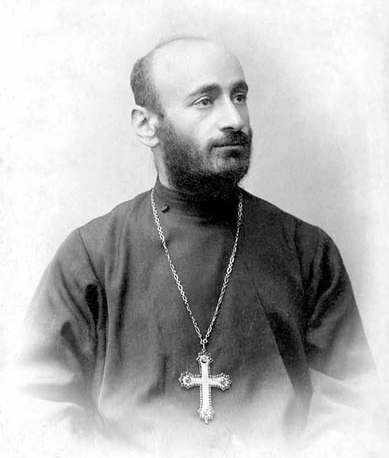
Komitas Vardapet
Soghomon Soghomonian, ordained and commonly known as Komitas, (Armenian: Կոմիտաս; 8 October [O.S. 26 September] 1869 – 22 October 1935) was an Armenian priest, musicologist, composer, arranger, singer, and choirmaster, who is considered the founder of the Armenian national school of music. He is recognized as one of the pioneers of ethnomusicology. Orphaned at a young age, Komitas was taken to Etchmiadzin, Armenia's religious center, where he received education at the Gevorgian Seminary. Following his ordination as vardapet (celibate priest) in 1895, he studied music at the Frederick William University in Berlin. He thereafter "used his Western training to build a national tradition". He collected and transcribed over 3,000 pieces of Armenian folk music, more than half of which were subsequently lost and only around 1,200 are now extant. Besides Armenian folk songs, he also showed interest in other cultures and in 1903 published the first-ever collection of Kurdish folk songs titled Kurdish melodies. His choir presented Armenian music in many European cities, earning the praise of Claude Debussy, among others. Komitas settled in Constantinople in 1910 to escape mistreatment by ultra-conservative clergymen at Etchmiadzin and to introduce Armenian folk music to wider audiences. He was widely embraced by Armenian communities, while Arshag Chobanian called him the "savior of Armenian music". During the Armenian genocide—along with hundreds of other Armenian intellectuals—Komitas was arrested and deported to a prison camp in April 1915 by the Ottoman government. He was soon released under unclear circumstances and, having witnessed indiscriminate cruelty and relentless massacres of other Armenians by the Ottoman Turks, Komitas experienced a mental breakdown and developed a severe case of post-traumatic stress disorder (PTSD). The widespread hostile environment in Constantinople and reports of mass-scale Armenian death marches and massacres that reached him further worsened his fragile mental state. He was first placed in a Turkish military-operated hospital until 1919 and then transferred to psychiatric hospitals in Paris, where he spent the last years of his life in agony. Komitas is widely seen as a martyr of the genocide and has been depicted as one of the main symbols of the Armenian Genocide in art. |
 = Recordings are available for online listening.
= Recordings are available for online listening.
 = Recordings were issued from this master. No recordings issued from other masters.
= Recordings were issued from this master. No recordings issued from other masters.
Recordings
| Company | Matrix No. | Size | First Recording Date | Title | Primary Performer | Description | Role | Audio |
|---|---|---|---|---|---|---|---|---|
| Victor | BVE-62314 | 10-in. | 5/27/1930 | Haiastan | Armand Tokatyan | Male vocal solo, with orchestra | composer |
Citation
Discography of American Historical Recordings, s.v. "Vardapet, Komitas," accessed November 24, 2024, https://adpprod1.library.ucsb.edu/names/102720.
Vardapet, Komitas. (2024). In Discography of American Historical Recordings. Retrieved November 24, 2024, from https://adpprod1.library.ucsb.edu/names/102720.
"Vardapet, Komitas." Discography of American Historical Recordings. UC Santa Barbara Library, 2024. Web. 24 November 2024.
DAHR Persistent Identifier
External Sources
Wikipedia: Կոմիտաս
Discogs: Komitas Vardapet
Grove: Komitas Vardapet
IMSLP: Komitas Vardapet
IMDb: Komitas Vardapet
Britannica: Komitas Vardapet
Linked Open Data Sources
LCNAR: Komitas, Vardapet, 1869-1935 - http://id.loc.gov/authorities/names/n80028497
Wikidata: Կոմիտաս - http://www.wikidata.org/entity/Q351670
VIAF: http://viaf.org/viaf/7574386
MusicBrainz: Կոմիտաս - https://musicbrainz.org/artist/01fbf8ab-34e2-4a0a-8dcc-8d9a8026d782
ISNI: 0000 0001 2036 9444 - http://www.isni.org/isni/0000000120369444
Wikipedia content provided under the terms of the Creative Commons BY-SA license
Feedback
Send the Editors a message about this record.
